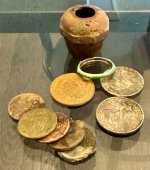Donut
Sr. Member
- Jan 25, 2010
- 392
- 334
- Detector(s) used
- Xterra 70 6" 7.5khz concentric 9" 7.5Khz concentric, 5x10 18.75Khz DD, 10.5 18.75Khz DD.
. Don’t expect to learn the NOX overnight it is a very good machine and it takes time and I’m still learning but I had a similar machine Minelab Exteria 70 so crossing over to the Nox was easier for me. And I’ve been detecting for over 45 years.Im no expert having only been MDing for a few months, but if it was picking up the wire fence you should get the same/similar signal at that distance the length of the fence. 4 of the little dig arrows indicate approximately 8"s deep, so my guess is that the object was just under the root a little ways.
On another note, i love the EQ 800....my only "complaint" is the emi at some locations. Changing sensitivity & recovery speed helps. May be bad one hunt & not the next hunt. Repetitive Noise cancelling helps, but gets annoying. However, the Equinox still always finds good stuff even under the tough conditions if you can just slow down & hunt thru the emi! Good Luck!
The fence. You will never be able to eliminate it but sometimes you can get closer by de tuning and not all the time.
As Far as EMI chatter sometime the multi freq is just to much and that is why I said to go to a single frequency like 10khz and that may solve the EMI , I always leave my iPhone in my car. Depth. The size of the find can be deceptive as well as angle, corrosion and oxidation that creates a halo in surrounding dirt around the target , you just have to dig. Nothing is exact in detecting. But just have fun as you go.
Doug


 I did move down further by the fence about the same distance and the signal died off...so Im guessing theres something there just a bit deeper...
I did move down further by the fence about the same distance and the signal died off...so Im guessing theres something there just a bit deeper...

 I’m not gonna follow behind you
I’m not gonna follow behind you 


